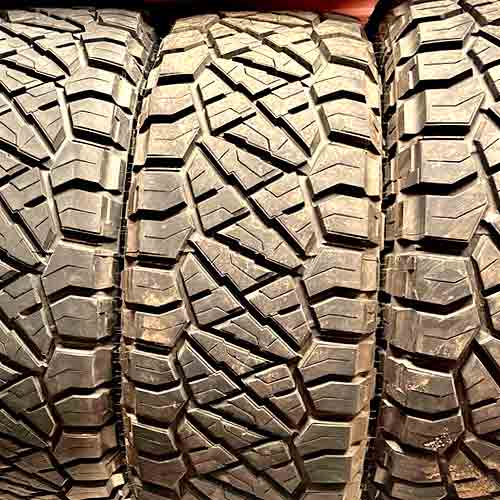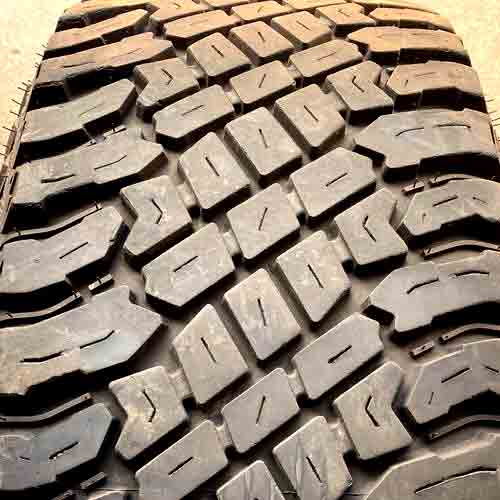Both the Atturo Trail Blade XT and the Nitto Ridge Grappler are two beasts made for tough terrains, though they still deliver above average performance on smooth tracks as well. But which one comes out on top when compared side-by-side? By the end of this article, all your questions will be answered. Let’s begin!

Being a tire engineer, from my perspective, the Atturo Trail Blade XT provides a better wet and dry traction on roads, where’s it’s also great with fuel efficiency. Moreover, other terrains where this tire is better includes snow, and sand. On the other side, the Nitto Ridge Grappler shines on rocky and gravely terrains, and it’s mud performance is also a lot better. On-roads, although it’s need some wet traction it does great with dry ones, and shows exceptional tread life.
Table of Contents
Sizes Available
The Nitto Ridge Grappler offers 98 total sizes, in 16 to 24 inches, with following specs:
- Load ratings available: SL, XL, D, E and F.
- Speed ratings available: T or Q.
- Weight range : 36 lbs to 91 lbs.
- Tread depth range: 13/32″ to 18/32″ (Most common: 16.4/32″).
- Sizes have no mileage warranty or 3PMSFR.
On the other hand, the Atturo Trail Blade XT comes in 30 total sizes in 17 to 24 inches with following specs.
- Speed rating: Q, S and H.
- Load rating: XL, C, D and E.
- Weight range: 30 to 84 lbs.
- Tread depth range: 13.5 to 18/32″
- Not rated with 3PMSF.
- 45,000 mile tread life warranty
Tread Structure
The Nitto Ridge Grappler features a symmetric tread design, with powerful inner and outer lugs.

The tire features a mixture of lateral and longitudinal grooves.
There are prominent zigzag circumferential grooves, diving the central, and outer lugs on the tread. Then there are Z/X shaped grooves in the middle connecting them.
All of these are formed with the 4 triangular blocks in the middle, carrying a lot of tread features.
They carry notches, sharp edges, off-sets, and reinforced foundations underneath.
Moving towards the shoulders, although they may seem less aggressive from the middle, these lugs have staggered edges, thanks to the thick mud scoops they form. And with dual sidewall designs, they provide bulkier lugs on both sides.
(Dual sidewalls basically give you the option to show two different sides of a tire with the rim outside).
On the other hand, the Atturo Trail Blade XT features a pretty biting structure.

Basically this tire has a lateral orientation of blocks, which means, they are chained up horizontally, instead of longitudinal arrangement, that you mostly see on other “typical” tires.
All these lugs, as you can see, form a very squared-off structure, and collectively, they work as paddles, scooping out loose stuff such as sand and mud.
Though with less wider grooves, they are still not so efficient in comparison.
Nonetheless, their closed up tread voids, do provide you with a greater rubber to road contact, rendering better gripping and stability on highways.
Moving towards shoulders, the lugs are slightly more opened up there, that’s why you also get stone ejectors in them.
These lugs cater to the missing off-road traction, where adding to that are its powerful sidewall biters (though, the tire could use staggered edges on it’s shoulders).
Durability
Both of the tires come with 3 ply polyester casings, with dual steel belts on top, which are then reinforced by 2 cap plies of nylon.
But since the sidewalls of an off-road tire play a significant role in its overall durability, (as this area is the most prone to punctures), the Nitto Ridge Grappler gets to have a slightly upper hand, still. This is because of it’s thicker lugs on each side of the tire.
Highway Grip
When evaluating the dry performance of these tires, I looked at their grip, cornering ability and steering capabilities, let me talk about them.
Directional grip tells how much rolling friction a tire creates while moving straight. And here, besides, tread structure, and weight, the overall footprint is closely monitored.
Having said that, the Atturo Trail Blade X/T provides faster stopping, when fully braked (showing it’s superior directional grip). This is because the tire has more closed up blocks placed in the middle, and they make a smoother contact with the ground with their minimal tread features.
The Nitto Ridge Grappler on the other side, comes with a more balder design (from the middle), and it’s Z shaped grooves come in the way of the tire’s meeting with the road properly when rolling straight.
Though it’s handling abilities is on par to its counterpart, that’s because lateral traction depends on shoulders meet up with the road, and both tires have same. Though one can argue that due to better steering response seen on Atturo, it still better overall.
Wet Traction
When it comes to wet traction, there are two main terms involved, hydroplaning resistance, and wet grip.
Hydroplaning has to do with water evacuation through the grooves (so the tire would not float, or should I say hydroplane). And there are two things involved here, straight aqua, and curved aqua performance.
Although both tires have similar float speeds when moving straight, with lateral orientation of the lugs, the Atturo Trail Blade XT provides better curved aquaplaning (which tells how good a tire is at removing water form its grooves while turning).
Moving on towards the grip, the Atturo Trail again gets to have an upper hand, with it’s softer compound, providing better flexing abilities to its sipes, which sucks water particles coming underneath.
The Nitto Ridge Grappler with it’s harder compound is not able to provide its sipes with the needed flexibility.
Fuel Consumption
With greater weight and a lot more biters seen on Nitto Ridge Grappler, it makes sense why the tire uses more fuel comparatively.
With a heavier construction, all tread lugs on the tire would rub against the road with greater friction, and with more number of biters, that friction is going to get lower by any means.
In comparison, the Atturo Trail Blade XT with a lighter structure, and compact blocks arrangement would not allow for energy to get wasted in to the flexing of the lugs, rather than movement of the tire.
Off Road Performance
Off-road landscapes like mud can provide difficulties, while gravel and dirt filled roads may be better for on-road tires. Let’s examine these both, including rocks and sand.
On Sand
To ensure optimal performance on sand, the tire’s weight and tread must be considered, as lighter tires and softer treads result in greater traction. The whole focus is to avoid “digging” as it loses all gripping values.
And having said that, the Atturo Trail Blade XT is one of the best for the job.
The tire is smoother on the edges, and has laterally arranged lugs which provide the paddling effect with the ground, so with it the tire is not prone to sinking, and rather focuses on the forward momentum.
Nitto Ridge Grappler on the other side, although has the advantage of thicker lugs, which spread out with lowered air pressure and provide great floating abilities, with a heavier weight and a stiffer compound, it’s not able to outperform it’s counterpart here.
On Mud
When it comes to mud traction, out of both tires, although the Atturo Trail Blade XT is lacking here, its only by a tiny bit of a margin, and subjectively, you’d feel no difference.
The tire basically has closed up lugs, and missing proper sidewall lugs (though having ample biters, will discuss them later)
Moreover, with lateral orientation of the lugs, mud is only allowed to leave out through the tire form sideways, and this hinders the longitudinal grip.
Nitto Ridge Grappler on the other side, features grooves in all directions. It’s Z shaped lugs connecting outer wider circumferential channels cover all angles, and they evacuate the thick clay faster.
Moreover the tire’s thicker sidewall lugs provide digging +scooping, which is pretty helpful when the tire is knee-deep in mud.
On Rocks
Out of both tires, although the Atturo Trail Blade XT supplies robust internal construction, it’s not as capable to provide grip in all directions. These are the main factors for climbing on rocky terrains.
And Nitto Ridge Grappler with 3 ply sidewalls, with thicker lugs on top, provide durability and extra traction with lowered air pressure, and it’s biting lugs in the middle forming Z or X shaped grooves yield ample traction at multiple angles.
The Atturo with it’s lateral orientation of lugs is only capable of providing directional grip, and it’s sideways traction is compromised with it.
On Gravel and Dirt
Off-road tires may have a tough rubber composition, but without stone ejectors, they would lead on to the stones which would not only cause harm to the tread but also decrease the overall traction capabilities.
That’s why with with wider grooves, the Nitto Ridge Grappler does better here, even though both tires, provide good enough stone ejectors.
Atturo Trail Blade XT on the other hand, with joined up lugs (laterally), allow more areas for dirt particles to settle in. So its not able to outperform its competitor.
Ride Comfort
Atturo Trail Blade XT is a more comfortable tire overall, comparatively.
The tire’s softer compound accounts for better bumps absorption, and with lateral orientation of the lugs, the air particles coming in (mostly through the shoulder grooves), don’t hit the walls of the tread with as much force (which generates noise).
Nitto Ridge Grappler on the other side, feels jittery with its stiffer tread composition, and with wider grooves, it generated a louder tread overall, even though most of the noise gets dampened down with the help of pitch sequencing, which Nitto calls variable pitch tech.
Do A/T tires cause vibrations: https://tiredriver.com/do-all-terrain-tires-cause-vibrations/
Snow Traction
The evaluation of a tire’s performance in winter conditions is based on its ability to provide stability while stopping, handle turns with control, and accelerate effectively on various snow and ice surfaces.
And although both tires here are not graded with 3PMSF ratings (only have M+S), I am really impressed with the performance of Atturo Trail Blade XT. The tire features elongated shoulder lugs, and a laterally connected (slanted) blocks in the middle. Both of these provide the “scooping” effect on the fluffy snow.
(Winter tires usually have similar swooping lugs on them, though they are directional).
Nitto Ridge Grappler on the other side, although features a good amount of biters to grip, the lugs don’t paddle, like the other tire.
To End
Atturo Trail Blade XT with it’s less aggressive structure provides better dry and wet pavement performance and the tire is pretty great with fuel, ride comfort and snow performance.
On the other side, the Nitto Ridge Grappler features superior off-road traction, on gravel, rocks and muddy tracks. And on-road, you’d be impressed with it’s stability, given it’s a more aggressive rugged terrain tire.